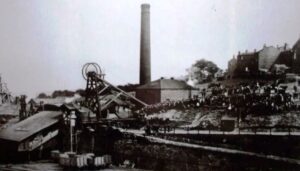
Thornhill Combs Colliery 1893
Taken at the time of the explosion that claimed the lives of 106 men and boys. The crowds on the right are awaiting news of their loved ones.
Thornhill Colliery was situated 9½ miles south south-west of Leeds and 1½ miles south of Dewsbury, in the village of Thornhill.
During 1855-57, Thornhill Combs Colliery was sunk to access the 40-inch thick New Hards (Low Hards or Cromwell) Seam, at a depth of 114 yards. The Colliery was sited on land owned by Lord Savile, in the Combs area of Thornhill. The Pit had two shafts — an 11-foot diameter downcast and a 12½-foot diameter pumping shaft – set at 30-yard centres, on an east/west axis. The shafts were lined throughout with locally produced bricks and had finished sumps at a depth of 116 yards. A small section of tubbing was placed in each shaft, in the vicinity of the Flockton Thin Seam. The downcast shaft was equipped with a 35 hp Bradley & Craven steam winding engine in 1856. The Colliery was on the dip-side of the mineral area and the pumping shaft was required to drain the large inflow of water from old workings, some of which were 120 years old. A steam pumping engine operated continuously, draining 980 gallons of water per minute. Production in the New Hards Seam started in 1857, using bord and pillar methods, hand-filling into 4½ cwt tubs. By 1872, the Ingham family employed 360 men and boys in its Thornhill pits.
In 1876 the Combs downcast shaft was deepened to the 18-inch thick Blocking Seam at a depth of 165 yards ready for when the New Hards Seam became worked out.
The sinking of the Ingham Colliery began on the 3rd of August 1875 on a site 1330 yards west of Combs Colliery. This comprised of two shafts set at 75-yard centres on an east/west axis. The No.1 Shaft was a 13-foot diameter downcast and the No.2 Shaft was a 14-foot diameter upcast. Both shafts were brick-lined throughout and sunk to the 28-inch thick Low Moor Black Bed Seam, at a depth of 276 yards. Finished sumps were formed in both shafts in late 1877, at a depth of 316 yards. The sump horizon was the Low Moor Better Bed, a 10-inch thick seam of fireclay. Insets were made in each shaft, at a depth of 188 yards in the Upper Shertcliffe horizon. Both shafts were fitted with wooden headstocks and equipped with steam winding engines by Pigott & Farrar (Barnsley) in 1876. The shafts were equipped for winding coal, with double-deck cages carrying 2 x 4½ cwt tubs per deck.
In 1877, the No.2 Shaft was equipped with a Guibal steam-driven ventilation fan, manufactured by the James Nelson Co. The Black Bed Seam was worked from No.1 Shaft and haulage was provided by a surface-mounted, steam-driven engine, located near the top of the shaft. From 1888, the Beeston Seam was worked from the inset in No.2 Shaft and a similar steam-driven haulage engine was sited near the top of the shaft. Steam raising was provided by 5 x Lancashire Boilers. Six sets of double-bar, fixed screens sorted the coal from both seams. Only coal was wound at the shafts, all dirt being packed underground. Slack from the screening process was carbonised in the 1851 ovens, adjacent to the Colliery. In 1883, Ingham Colliery was connected to the Yorkshire & Lancashire Railway via a 1½ mile branch line to Thornhill Station.
The New Hards workings at Combs Pit were approaching a 40-yard downthrow fault in the east of the take. The decision was made to sink a staple shaft from the New Hards on the west of the fault, down to the Blocking Seam and connect it to the 1875 deepening of Combs No. 1 Shaft, to create a ventilation circuit. When the circuit was complete, the New Hards on the east of the fault was to be accessed via a drift from the Blocking horizon. The ventilation of the Combs workings was provided by the Guibal fan at Ingham No.2 Shaft. The sinking of the staple shaft was started in 1883 and was close to the bottom of the Combs pumping shaft. It was connected to the pumping shaft by a short, 20-yard drift, to allow water pumping to continue. The sinking of the staple shaft was completed in April 1884 and work commenced to reach the New Hards Seam, to the east of the fault. This work was finished in early 1885 and production in the eastern New Hards started soon afterwards, by bord and pillar methods. Working in the western New Hards ended in 1886 and that section was abandoned in 1888.
The New Hards Seam to the east of the fault in Combs was much poorer in quality than the west and so working ceased here at Christmas 1888 and the seam was abandoned three months later. The colliery turned its direction to work the 30-inch thick Wheatley Lime Seam. The Wheatley Lime was 139 yards below the surface and it was planned to work the Seam from an inset in No.1 Shaft at Combs. A wooden landing was inserted in No.1 Shaft, at a depth of 140 yards and a wooden inset chamber was made into the seam. A 4-foot gap was left in the landing to ventilate the Blocking horizon.
By 1893 the Wheatley Lime Seam was being worked by pillar and stall methods, about one mile from the shaft. The seam was wet and was worked with Marsaut-type safety lamps. although naked lights were in use 600 yards inbye on both sides of the shaft. Six paraffin lamps were used to light the porches leading to the seam.
On 4th July 1893, an explosion at the colliery caused the deaths of 139 men and boys. The full report can be found here.
During 1905-08, a major reorganisation took place at the Thornhill Collieries. In 1905, the Combs downcast shaft was deepened to a new sump depth of 370 yards, at the Better Bed Fireclay horizon. A pit bottom was made at the Black Bed Seam at 369 yards and an inseam connection was made to Ingham Colliery, to create a ventilation circuit. The Guibal fan at Ingham No.2 Shaft was replaced by a more powerful, steam-driven Walker (Wigan) Indestructible fan. The earlier 4½ cwt tubs were replaced by 6½ cwt tubs, to increase shaft capacity.
Manpower had remained constant from 1923 until 1940. at 886 men, but decreased to 709 men when a number of miners joined he armed forces during WW2. A canteen was opened at Combs Colliery on 14th April 1942. By 1945, manpower had fallen further to 663 men, of which 143 were employed at Combs.
On Nationalisation in 1947, Combs and Ingham Collieries became part of the NCB North Eastern Division No.7 Wakefield Area. At this time, the Collieries were producing 180 tons per day of Black Bed and Blocking Seam coal from Ingham No.1 Shaft, 450 tons per day of Beeston and Wheatley Lime coal from Ingham No.2 and 140 tons per day of Black Bed and Wheatley Lime coal from Combs No. 1 Shaft.
On 9th September 1947, an explosion of firedamp killed 11 men and injured 1 other, the report can be found here.
In 1948, Combs and Ingham Collieries were combined as Thornhill Colliery. Workings in the Wheatley Lime Seam ended in 1948 and the Seam was abandoned on 20th April 1949. By the early 1950s, the system of winding 4½ and 6½ cwt tubs was more and more uneconomic. With an estimated 25 years of coal, at an output of 1000 tons per day, remaining at the Colliery, it was deemed justifiable to carry out a reconstruction scheme in order to provide a modern haulage system, utilising large minecars wound at one shaft and a reduction in the steam raising plant at the Pit.
The old Combs pumping shaft was converted into a new winding shaft for coal. At this time, working of the Black Bed Seam was ended and the winding of coal ceased from Combs No.1 Shaft. The water shaft was filled with ashes from the coking plant, to allow widening to take place. The shaft was widened to 16-feet diameter and a shaft collar was constructed by the NCB. The NCB then carried out the first 40-feet sinking, using a crane. Outside contractors took over and sank to 122 yards depth (enlargement) then continued as a sinking-proper, to a finished sump depth of 260 yards.
Prior to the commencement of deepening works, it was necessary to de-gas the Blocking Seam. At that time, the Blocking Seam atmosphere was 86% methane. The new shaft was lined throughout with poured concrete. A shaft eye and pit bottom were formed at a new locomotive road horizon, at 251 yards (27 yards below the Beeston Seam). The locomotive toad was driven, 950 yards long, to an intersection in the Beeston, where a central loading point was installed, with coal delivery by conveyor. A locomotive garage, repair station and underground offices were also constructed. A minecar circuit was established around the hew pit bottom. The new shaft was fitted with a steel headframe and a new winding house was constructed. The shaft was equipped with a 500 hp electric winding engine, attached to single-deck cages, carrying 1 x 22-ton minecar. Underground, 68 hp diesel locomotives, capable of hauling a train of 20 x 22-ton minecars, were introduced and 4½ and 6½ cwt tubs were replaced by 22-ton minecars. Underground construction was completed in 1957.
By December 1957, the surface section of reconstruction was finished and the £530,000 scheme was complete. Coal winding had switched from Ingham No.2 to Combs No.2, in August 1955. At that time, both Ingham Shafts had become upcasts and were equipped with electric ventilation fans. Combs No.1 was equipped with a 150 hp, parallel drum, electric winding engine to replace the old steam winder. Pithead baths, with facilities for 520 men had been opened as part of the surface reconstruction.
The NCB had plans to link together, underground, the 3 Pits in the Dewsbury Coalfield (Thornhill, Shaw Cross and Old Roundwood). It was hoped that the 40 years of reserves remaining in the Dewsbury area, could eventually be worked from Old Roundwood. In May 1956, the connection between Thornhill and Shaw Cross was some 900 yards long. The connection between the Shaw Cross and Thornhill locomotive roads was completed in 1960. From that time, Thornhill coal was wound at Shaw Cross, for washing. Men and materials continued to be wound at the Combs Shafts. The intended underground connection between Shaw Cross and Old Roundwood Collieries was never made. Old Roundwood was closed in April 1966, due to exhaustion of reserves, thus ending the possibility of mining Dewsbury coal from that site.
The working of the Beeston Seam at Shaw Cross ended on 19th July 1968 and Shaw Cross was officially closed. The Thornhill and Shaw Cross Collieries were merged on 1st November, to form the Thornhill Combined Mine with the remaining Shaw Cross reserves being worked from the Thornhill section. From this time the underground connection between the two collieries was sealed off and coal winding was resumed at Combs No.2 Shaft.
Thornhill Colliery continued to work the Beeston Seam until its closure on 28th April 1972, due to the lack of reserves and the changing economic climate.
Sources
- Yorkshire Collieries 1847-1994, Downes. E.
- NMRS Records

